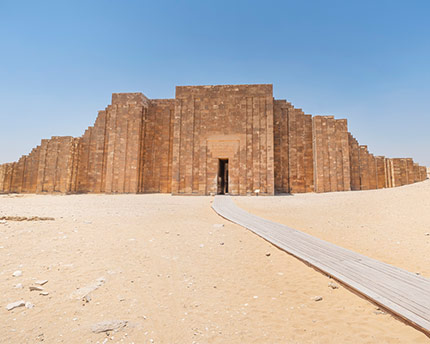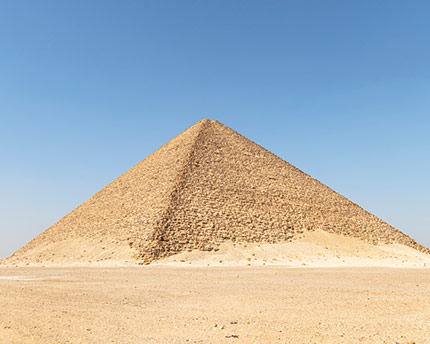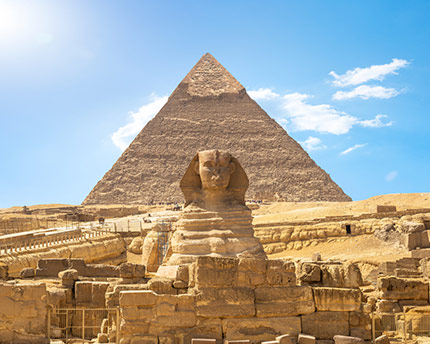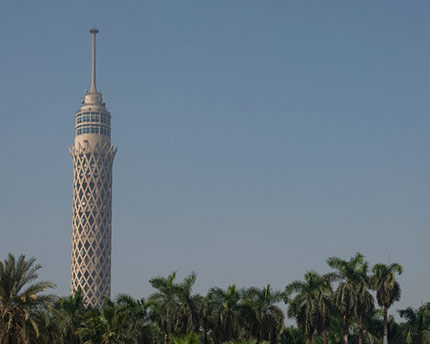It’s less famous than the Giza necropolis, but the city of the dead at Saqqara has the same appeal (or almost the same) as the one in Giza. One disadvantage that has counted against it is that it’s further away from Cairo than Giza. Although it’s only about 30 kilometres from the capital, on the way there it offers an alluring desert landscape on one side and green, palm-fringed scenery along the banks of the River Nile on the other.
Visits to Saqqara are often planned with the sole intention of seeing the pyramid of Zoser, which everyone knows from history books. That said, you should go a little further and organise a more ambitious visit. A guided tour if possible. Although the distance between the various monuments in Saqqara isn’t too great, an interesting option is to organise an excursion that takes you by car to the different pyramids and mastabas. There’s a museum with a cafeteria on the site itself, a place to take a break from the sun if you go in summer. Are you ready to walk through a necropolis with over 3,000 years of history?
What to see in Saqqara
The area occupied by the necropolis of Saqqara, some six kilometres long and 1.5 kilometres wide, makes it one of the largest necropolises since ancient times. The area is usually divided for study and visits between the northern and southern zones. Inside this large cemetery, the pyramid of Zoser stands out because of its importance and reputation. We’ll talk about it in the following section, and we’ll take a look at other interesting tombs as well.
Step Pyramid of Zoser
The Pyramid of Zoser, also known as the Step Pyramid, was built in the 27th century BC by the architect Imhotep at the request of King Zoser. Researchers believe that this was the first pyramid erected in Egypt, as well as the largest monument in the Ancient World. It seems that the original project differs from the pyramid itself with its pyramidal structure and six steps that can now be seen. It was originally intended to be a square mastaba, 63 metres on each side and eight metres high. However, the decision was made to add more layers of Tura limestone on the sides. The current pyramid has a base of 118 by 140 metres and a height of 62 metres. You have to go through a striking corridor with pillars to reach it. It’s believed that the remains of the pharaoh rested in the shaft of the South Tomb.
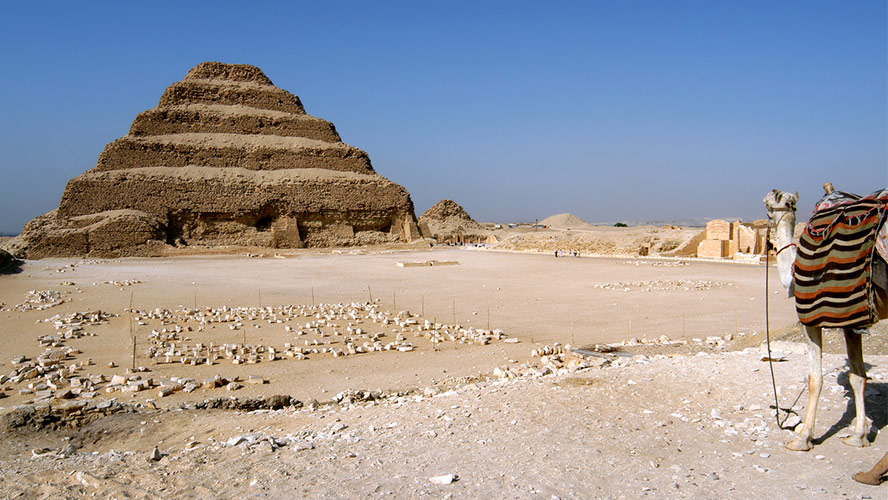
Pyramid of Teti
The pyramid of the pharaoh Teti, belonging to the 6th Dynasty, is another must-see part of the Saqqara necropolis. It’s semi-destroyed and from the outside it looks like nothing more than a strangely shaped hill, but don’t be put off by the exterior because you can head inside through a passageway to visit the chambers. Something to bear in mind is that the height of the passageways is only one and a half metres, although the chambers then reach three or four metres and you can stand upright. On several walls of the burial chamber are drawn texts, some of which still have the grid of the stencil. Egyptologists believe that the rush and the fact that the engravings weren’t finished indicate that Teti died prematurely, perhaps murdered, and there was no time to complete the tomb.
Serapeum
In the necropolis of Saqqara, there are not only pharaohs but also tombs with surprising “contents”. This is certainly true with regard to the Serapeum. Its interior was not discovered until 1851, the year in which the French archaeologist Auguste Mariette broke through a wall of the chamber of Ramses II and found the burial place of the sacred Apis bulls. One of these animals dedicated to the god Ptah was sacrificed every 14 years. Before being placed in the Serapeum, they were embalmed like mummies and placed in sarcophagi. As you can imagine, they’re very large, weighing over 50 tonnes. It’s an amazing visit, so don’t miss it.
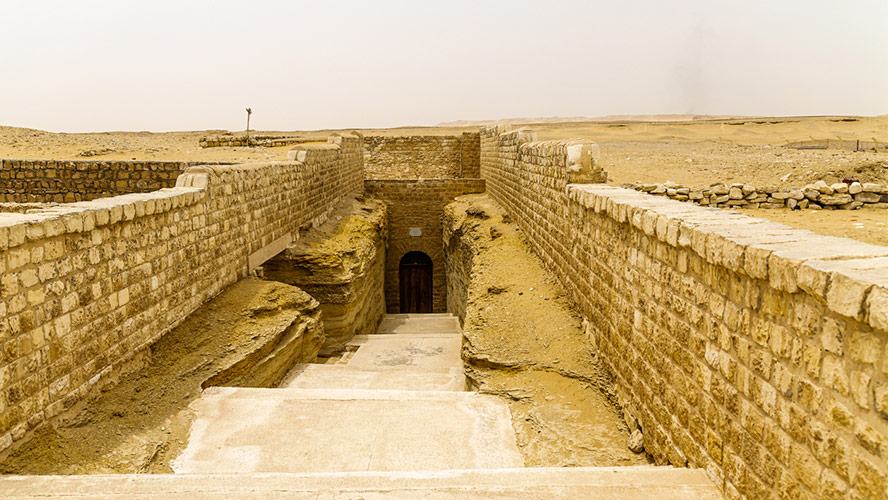
Tomb of Akhethotep
Among the many other pyramids and mastabas in the necropolis of Saqqara is the tomb of Akhethotep (Akhethetep), who was a high-ranking official in Egypt in the 5th Dynasty and probably the son of the famous physician Peseshet. The tomb was discovered in 1903 by Georges Aaron Bénédite and two other archaeologists. After its acquisition by the French government, he dismantled the funerary chapel and reassembled it in the Louvre Museum in Paris. Since July 2021 it has been on display in the French capital, fully restored. Interesting inscriptions and engravings can be seen on the tomb, including one showing Akhethotep directing the work on his own tomb. Despite how much it has been studied, there remains some mystery surrounding this tomb.
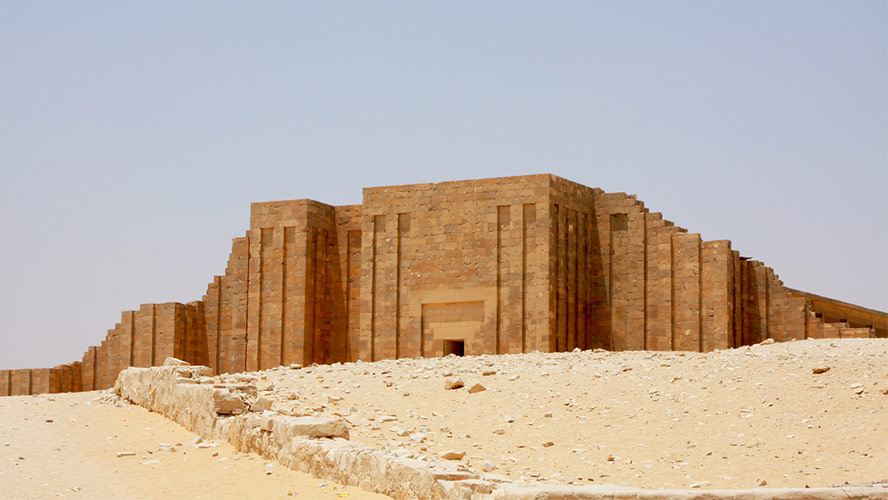
Where to eat in Saqqara
If you’ve planned this visit as a day trip from Cairo, you’ll want to eat near the necropolis of Saqqara to make the most of your time. One recommended option is the Pharous restaurant, which serves traditional recipes and often has live music. It’s located inside a large tent-like structure and is a lovely place to eat. However, it doesn’t serve alcohol, so you’ll have to eat your meal with another drink, such as a soft drink or tea. The Sakkara restaurant is also worth a try, with its simple but tasty food and friendly staff.
Where to stay near Saqqara
Among the best places to stay in Cairo, just 30 kilometres from Saqqara, is the Barceló Cairo Pyramids hotel. This four-star hotel is the ideal base camp for exploring Cairo and the surrounding area because of its high European standards. The establishment, located on Sharia Al Haram, has 236 large rooms divided into categories ranging from superior to junior suites and family rooms. Gastronomy is another of its strong points, with three bars and three restaurants, one of which is located on the 12th floor and offers stunning panoramic views of the pyramids of Giza. It also has a swimming pool, gym, and wellness area. A perfect hotel to enjoy Cairo.



























































